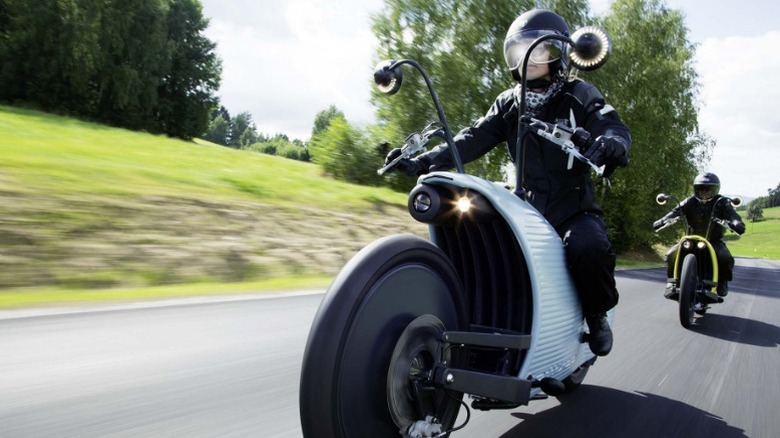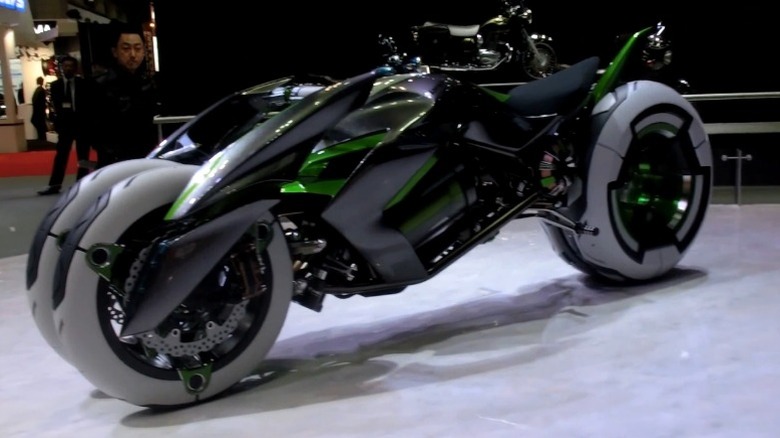6 Futuristic Motorcycles That Actually Exist
There are a lot of different kinds of motorcycles out there, but most of them conform to a handful of body styles. There are differences between makes and models of street bikes, sport bikes, cruisers, adventure bikes, and touring bikes on the market, but the vast majority of the vehicles in each category look relatively similar to each other. This is partially because the tried and true designs that we typically see are ideal for the physics of two-wheeled travel, but it's also because they are the styles that most consumers are currently looking for in any given generation. That said, there are always a few bikes out there that were designed with an eye toward the future.
A lot of bikes, such as the Yamaha PES2, Sonders Metacycle, Honda V4, Verge TS Pro, and MV Agusta Brutale 1000RS, have taken some creative leaps forward compared to their contemporaries, but there are quite a few bikes that have been made with even more futuristic designs. These vehicles challenge the norms that we've come to expect from certain breeds of motorcycle. Some of them are bespoke concept bikes that look like something out of a science fiction movie, while others have refined the designs that we're familiar with to the point that it looks like you're getting a glimpse of the future.
Johammer J1
Electric motorcycles have become a lot more popular in recent years, but most of them still have a fairly conservative design. The Kawasaki Ninja e-1, for instance, basically looks like any other sport bike. The Austrian motorcycle Johammer decided to take a different approach with its new electric motorcycle, the J1. The company describes this bike as an electric cruiser, though the design is unlike any other cruiser on the market.
Most of the bike is covered by a single continuous sheet of metal that almost looks as if it were heat-molded to the frame underneath. The only things protruding from this massive fairing are the front wheel, the handlebars, and the small, single seat. This gives the bike its unusual shape, which looks like something out of a film that also involves robots. Everything from the wheels to the forks to the headlight stands out, but the true engineering is in the way the bike is framed. Underneath the structural shell, the J1's chassis is completely linear. The electric motor is built into the rear wheel, while the shock absorbers and battery pack are adhered to a linear aluminum frame that connects the front and rear wheels.
There are two versions of the J1 currently available. The J1.150 has an 8.3 kWh capacity and a 92-mile range, while the J1.200 has a 12.7 kWh capacity and a 120-mile range. Speed is electronically limited to 75 mph.
Arc Vector
Next up is another electric motorcycle — the Arc Vector. You can definitely see the inspiration of modern sports bikes in the overall shape of this one, but there is a futuristic elegance to the design that makes the Vector look like it could be something out of "Cyberpunk 2077."
The overall look of the bike is incredibly slick — as you might expect from a bike that is hand-built. There is a continuous strip of fairing that runs from the headlight and over a hollow hump that imitates where a gas tank would be before dipping down to form the shape of a single seat that extends over the rear tire. Under this, there is a structural piece that contains the battery and connects the top of the bike to the wheels in place of a traditional frame. It refers to this unique structural design as the monocoque. "The Vector does not utilise a frame or a chassis," Arc states. "Frames were used to cradle engines — no engine means we no longer need a frame. To keep the weight down and maximise package space the answer was simple — the battery had to be the chassis and the beautiful aesthetic that people would see — The Arc monocoque was born."
Additionally, the Vector has a bespoke permanent rare earth magnet AC motor that produces 117 horsepower and can go from 0-62 mph in 3.1 seconds. It also has an advanced display and offers special Rain, Eco, and Road riding modes.
Motoroid 2
It isn't just small boutique motorcycle designers that make futuristic motorcycles — there are some pretty crazy-looking bikes coming from the bigger manufacturers as well. Yamaha, for instance, has an electric bike called the Motoroid 2. This is the updated version of the original Motoroid, which was first unveiled during the 2017 Tokyo Motor Show. It looks less like a motorcycle that you would expect to see on the road today and more like the sort of thing that you would expect to see whirring out of the loading bay of a spaceship in an episode of "Star Trek."
The bike is set on a massive pair of tires that certainly look ready to explore a bit of alien terrain, and the body is a design unlike anything else out there. The front-heavy design places a majority of the bike's weight above and immediately behind the front tire, giving it an almost animalistic shape.
This is by design. The first Motoroid had several automation features built in that allowed it to autonomously follow voice and gesture commands. Following this design philosophy, the Motoroid 2 was made to be more of a mechanical companion than a simple vehicle. "The best example of this is the haptic device, implemented as the iconic key structure known as the "LEAF,"" says Yamaha. "It is equipped with an optimized transform feature that responds to the mounting/dismounting situation, and not only accepts the rider's body depending on the riding posture but also works as a "tactile sense," that receives and responds to the rider's intentions."
Kawasaki J
Another unique concept motorcycle from a large manufacturer is the Kawasaki J. This is easily the oldest bike on this list, as it was first revealed during the 2013 Tokyo Motor Show. But despite being over a decade old, this bike is still one of the most futuristic machines ever to be conceived.
Its overall shape is reminiscent of the Lightcycles from "Tron: Legacy," but it isn't just a replica like the one made by Parker Brothers Concepts. There are several unique design elements as well. In its default position, the J has a linear body that forces the rider to lean far forward, with two wheels at the front that each have direct handle control and a large wheel at the back that is connected directly to the electric powertrain. But the most fascinating thing about the Kawasaki J is that it can actually change shape. The default lower riding position is designed for speed, allowing the vehicle to behave like a sports bike, but the wheels can also move out and back. This allows the bike to bend on an axis near the rear tire, lifting this seat and curving the bike into a shape that allows the rider to switch into an upright cruising position. Add some neon green metallic paint and a battery that looks like a miniature nuclear reactor at the center, and you've got a bike that still manages to look like something out of the future even a decade later.
BMW Vision Next 100
BMW has made some truly innovative motorcycles over the years, but there have been few that are more innovative or futuristic than the Vision Next 100. This is a concept motorcycle that BMW has earmarked as a "future scenario" bike, suggesting that it's something the company might consider putting into production in the future.
It has a completely unique framework. Starting at a large, front wheel, a structural piece of fairing comes up and then twists and curves over the handlebars before running along the length of the body to the rear tire. This architectural element gives the bike an alluring triangular shape that is simultaneously familiar and unlike anything else on the road.
Interestingly enough, this is one of the few bikes to make the list that aren't electric. At its core, the BMW Vision Next 100 is powered by an opposed-twin gas engine that is made to resemble a classic BMW Boxer. All of this is encased in a solid shell with cooling fins at the front and side.
BMW also makes the ambitious claim that the Vision Next will be so safe that riders won't require a helmet or safety equipment due to an automated safety function built into the bike. "The "digital companion" — a functional unit consisting of motorcycle and our own version of rider's equipment — ensures a high degree of safety. The digital companion acts imperceptibly in the background and always intervenes when required or desired." It's unclear if this technology currently exists, or if this is something BMW is planning for the future, however.
TMC Dumont
Finally, we have the Dumont. This futuristic motorcycle was designed by none other than retired Formula 1 racer Tarso Anibal Santanna Marques who builds custom vehicles with his company, TMC. This is a particularly unique piece even among TMC's eclectic mix of bespoke cars and bikes, as The TMC Dumont pairs its eye-catching sci-fi design with an actual airplane engine.
The bike first debuted during Daytona Beach Bike Week in 2018. It sits on a pair of massive, hubless wheels that are taller than the bike itself. These are a large part of the vehicle's visual appeal, but they aren't the only thing that makes the Dumont stand out. Its body hovers mere centimeters from the ground and primarily exists to support the massive, 300-horsepower Rolls-Royce Continental aircraft engine that powers the bike and takes up nearly half of the overall body. The seat is positioned directly behind the engine (dangerously close to the rear tire) and the handlebars are positioned on either side of it. At first glance, this might make you question whether the bike is even ridable — but it absolutely is, and according to Wonder World, Marques always rides it when he brings it to bike shows rather than loading it onto a truck for transport.






